Category: article
You are viewing all posts from this category, beginning with the most recent.
Adventures of an Expat Cord Cutter
Adventures of an Expat Cord Cutter
Even thought I’m living abroad and traveling for an extended period there are a few entertaining parts of my life I’m not willing to leave behind. Watching Arsenal, keeping up with The Big Bang Theory, The Blacklist, Food Network, and a few others. How you do this is well covered territory. You can probably figure it out with several google searches, but it seems worth it to collect my own efforts into one cohesive post. Here are the problems to solve:
- How to stream TV shows that have geographic restrictions. Lots of content is available only inside the borders of the USA.
- How to get the content off of your small screen and onto a larger screen if you are lucky enough to have one.
- How to optimize your WiFi and streaming throughput in the midst of an urban WiFi jungle.
Warning. This is a geeky technical post. You can quit here and I won’t feel bad.
Streaming
There are lots of options for streaming from places like Hulu, Netflix, and even the big four major networks all have apps now that let you stream more or less of their content. When we left home, I had NBCSportsLive Extra, Netflix, HBO Go, DirectTV all installed on my iPad. I also have iTunes, and had downloaded a few movies that I had on my list to watch. In the United States this would be fine, but all of these apps (except iTunes) have geographic restrictions on them. So I also had to subscribe to a Virtual Private Network (VPN) service and configure that on my iPad.
VPN
If you are not familiar with a VPN you can think of it as a bit of software that messes around with your network configuration to make the rest of your computer and the rest of the world think that you are a part of some other network. This is often used in large organizations where you have content that you restrict to your own institutional network. Luther does this with some resources, like our network drives. Other services, such as O’Reilly’s Safari, may check to make sure that you are coming from a particular network before you are granted access to their own content because of a corporate licensing agreement. If you have a VPN connection back to your institutional network then it is just like you are in the office and not at home or halfway around the world.
Now the reason this is important for my entertainment is that there are many VPN services that exist partly for the purpose of making it look like you are connected to a network in the United States somewhere rather than a network in Vietnam or Malta. I signed up with Private Internet Access These services also have the side effect that your content is encrypted from the time it leaves your computer until it leaves the VPN provider, which many people look at as a significant privacy benefit. Using a VPN to trick NBC into thinking that I am in the united states might be considered a moral gray area, but I’m still paying my DirecTV, and Mediacom bill every month back home every month so I don’t have any problem going to sleep.
The VPN solution works pretty well, except for some content providers have figured out how to identify these VPN servers, and have made moves to block the connections from known VPN providers. I’m looking at you ABC.
This content blocking thing is interesting, especially from companies like ABC that force you to watch commercials as part of their streamed offering. Why wouldn’t they want more eyeballs on their commercials?
To the Big Screen
Once we got settled in our flat in Malta, I decided I wanted to upgrade the streaming experience by adding an AppleTV to the TV in our flat. With this setup, I can use Airplay to send the content from my iPad to the larger screen we had set up in our living area. Except that it doesn’t work. The AppleTV has no provision for joining a VPN. There are some ugly hacks that involve jailbreaking your AppleTV but I didn’t want to go there. I’d rather install more iPad apps for streaming FoodTV, Fox Sports, and several others that I’ve added to the list since we arrived.
Here is our Entertainment center in our flat in Sliema.
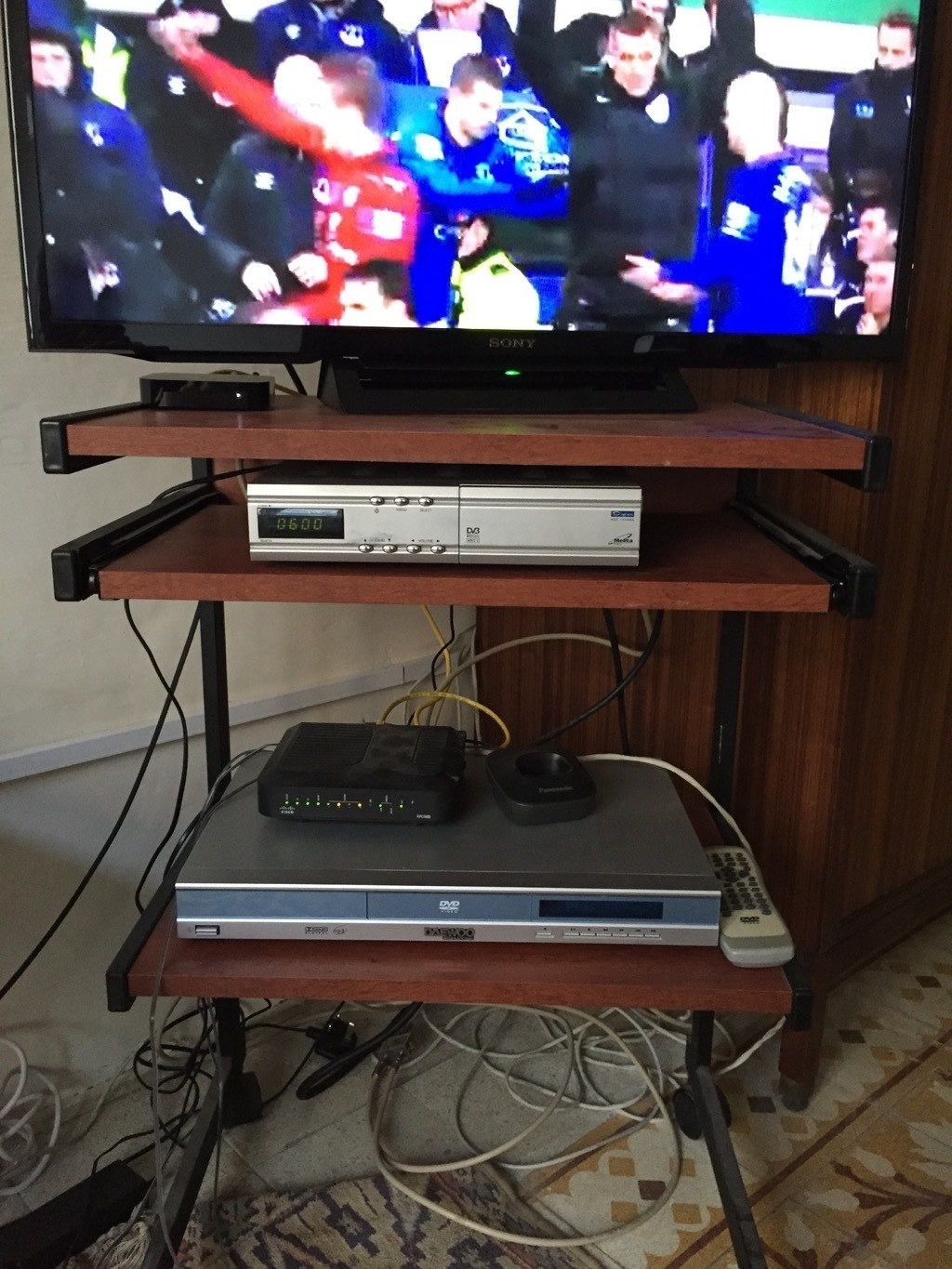
DNS
The Domain Name Service is at the heart of the Internet. If you haven’t been subjected to my days of DNS in Networking class, you can think of it like a phone book for the entire world. Of course its way more fun and complicated than that.
So what does DNS have to do with this particular problem? Well, when you want to contact a website or stream some video, you need to look up the address of the server that authenticates you, and checks to see that that address is in the right country. You find the address by contacting your friendly local DNS server. You normally don’t have to worry about this because your home router takes care of it. But, it is an easy thing to customize. It turns out that these video streaming services use one server for authentication, and a different server for video streaming.
With me so far? Now there are companies that provide DNS services to replace the DNS provided by your friendly neighborhood Internet Service Provider. For example Google runs DNS servers that you can use. They are really reliable, and of course keep track of all the addresses you look up to better inform their search algorithms I suppose. However, if google wasn’t trustworthy, you could ask them for the address of company X, and they could lie to you so you connected to company Y.
In order to avoid a full VPN, and to make it easier for helping iPads, iPhones, and AppleTVs get around the geographical restrictions there are some companies that are running their own DNS servers that will in fact lie to you about the server you connect to for the authentication part of setting up a video stream. This little setup is actually called a proxy. So when you ask for the address of the ABC authentication server you don’t connect to ABC you connect to one of the servers run by UnoTelly. UnoTelly sits between you and the authentication server and passes on your information. But since the UnoTelly server is in the United State, ABC thinks you are in the United States too. With the authentication taken care of UnoTelly gets out of the way and allows your AppleTV to connect directly to the streaming server. So far the UnoTelly servers remain blissfully below the radar of content providers everywhere. Yay technology. Also, DNS is very easy to customize even on your AppleTV.
This is a silly arms race between the VPN Providers, the DNS providers, and the content providers. Hopefully this will sort itself out in a saner fashion sometime soon. In the meantime its likely that every time the content providers find one way to block some clever software engineer will figure out a way around the block. It reminds of of disk copy protection software in my younger days. No matter what scheme a software company came up with to block copying, someone would figure out a way around it.
Optimizing your Streaming
Which brings us to our final problem. How to optimize your streaming in the WiFi jungle. The flat we live in is in a very densely populated area. My WiFi Scanner program shows between 15 and 20 different access points depending on the time of day and day of the week. With this many access points there is a lot of interference because everyone is trying to use a rather narrow band of the radio spectrum at the same time. Although WiFi is divided up into 11 different channels, there are really only 3 of the channels that don’t overlap and interfere with nearby channels.
So the best solution is actually to use wired internet if you can. luckily my AppleTV and my Router sit right next to each other, so its easy to plug in. Even when I am using Airplay from my iPad to send something to the AppleTV the stream ends up coming directly through the wire rather than over WiFi.
If you can’t plug in, then you might think that the thing to do is to choose a channel that isn’t being used by one of your neighbors. It turns out that most routers use channel 1 or 6 or 11 by default. So your first thought might be to use 2 or 5. But that will actually make the problem worse, because 1 and 2 will be unaware of each other and just make interference. The counter intuitive solution is to pick the same channel as your neighbor with the strongest signal. This way the normal Carrier Sense Multiple Access with Collision Avoidance (CSMA/CA) algorithm can actually do its work. Yep, CSMA/CA is another day of networking class, but now you can throw that around like your an expert the next time someone brings up WiFi.
So with all of this, we have a pretty good setup. I can catch up on shows on all of the major networks, I can stream English Premier League Football, and FA cup, and Champions league. I can watch FoodTV, and of course we can watch anything that is on the AppleTV. Just last night we finally got around to watching the Theory of Everything. Of course some times are better than others, and some providers are better than others. AppleTV is top notch all the time. I always get a good stream on anything I watch on any of the apps on the AppleTV. Sadly its the sports streaming FoxGo, and NBCSports Live Extra, that seem to fall down. I don’t know if they are not built out enough to handle the worldwide demand, or what the deal is. But there is a lot of season left, so I hope they keep on improving.
When I get back home I probably will not remain a cord cutter. Too much content still relies on me having my DirecTV password to show that I am paying for it. To often, I have to play technical support person in the middle of a show to restart the stream. But it does make me wonder about our lake house. Do we really need two DirecTV subscriptions, especially for the amount of time we spend watching TV there, and with our Fiber Optic connection just around the corner, the bandwidth we’ll have for streaming in the middle of Wisconsin lake country will be quite amazing.
Butchers, Bakers, and Sandwiches
Butchers, Bakers, and Sandwiches
After a cold morning of touring the colliseum and other ancient roman ruins, we had the chance to meet the Maltese ambassador to Rome, Vanessa Frazier. She happens to be a Luther alum, and was extremely gracious in receiving us and telling us some great stories. I think it is always really valuable for Luther students to hear the pathways that alumni take after leaving Decorah.
Here is the group, pictured with our guide Nino. We all loved him and will always remember the phrase “Nino is here” as it sounded inside our earbuds that constantly linked us to Nino. Yes, Nino really does have his own website called Nino Knows.
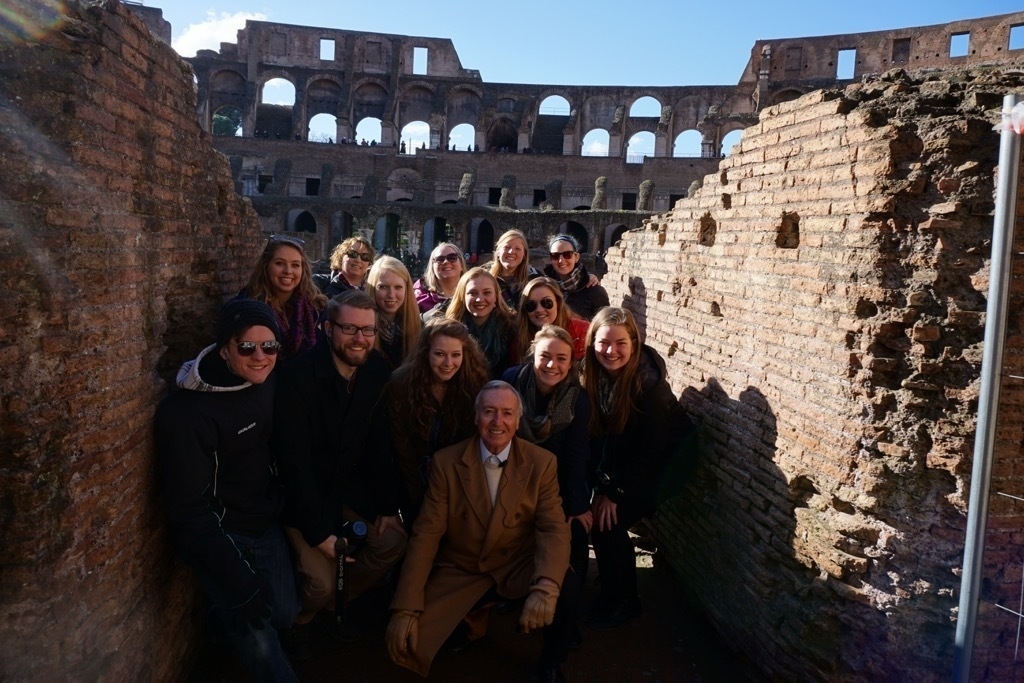
One interesting story from the ambassador involved teaching a certain beloved Luther professor how to say “good morning” in Maltese. The prof cheerfully greeted her the rest of her days at Luther with that little bit of Malta. Only she didn’t really teach him to say good morning. The next time you see Uwe you’ll have to ask him what she really taught him to say! I can’t wait to see hime when I get back to hear his side of the story.
When we asked her what an ambassador does on an average day she told us the following story, which I love, because it gets to the heart of what everyone needs to do to be successful in their career. She said that on her first day in the foreign service an older, wiser colleague told her that on the first day she needed to go into the streets and find a butcher, and talk to the butcher about meat. On the second day she needed to go into the streets and find a baker and talk about bread. On the third day she needed to go into the streets and talk to the people about sandwiches.
In the end its about networking and making connections. This is what everyone needs to do to be successful. Make connections with people, learn how you can help them, and how they can help you. You will get much farther if you have a network that can collectively solve problems together.
Ostia Antica
Ostia Antica
Ostia Antica
Ostia is about a half hour train ride away from the center of Rome, back in the direction of the airport and the coast. In fact Ostia was the port for Rome in ancient times, until it fell out of favor. Slowly the city became covered with silt from the river until it was buried and forgotten. The layers of silt have preserved the city very much like the ash from the volcano preserved Pompeii. We had no formal guide this day, but it was still fun, to just walk and imagine yourself in that place in ancient times.
Here I am serving wine to the ladies at an ancient bar.
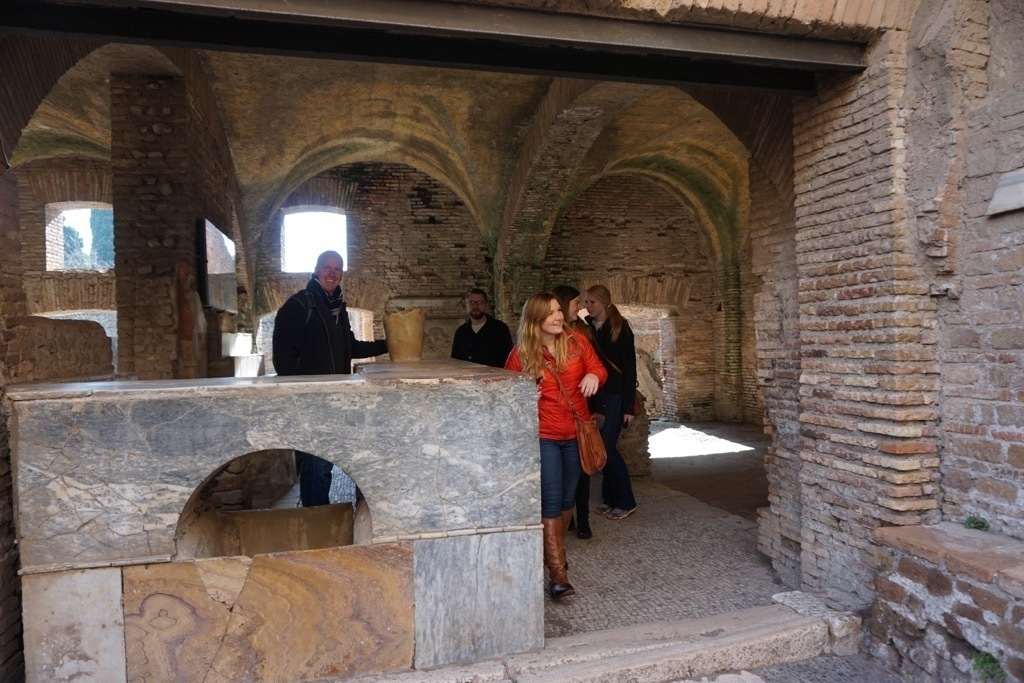
|
And here are some scenes from above. I love the trees. They remind me of giant bonsai because they all appear to be so well groomed.

|

Vatican Day
Vatican Day
The Vatican
Hiding behind the ancient dirty exteriors of the buildings of the old city of Rome are beautiful palaces, with works of art as beautiful as those in the Vatican Museum. We Romans know how to live! So says Nino, our guide for our day at the Vatican. He is right too, when you walk around at night, and look into the windows of some of the places you see, you will notice that although the exteriors look pretty shabby, the interiors are very beautiful.
Having a guide is really the only way to go when visiting the vatican, otherwise you just wander around aimlessly looking at stuff without knowing the story behind all of the amazing things you see.
I’ve always been drawn to this photo on the ceiling of the first of the Raphael rooms, wondering what it was all about. The title really tells you all you need to know. The Triumph of Christianity. The fresco was commissioned by Pope Gregory XII in 1582.
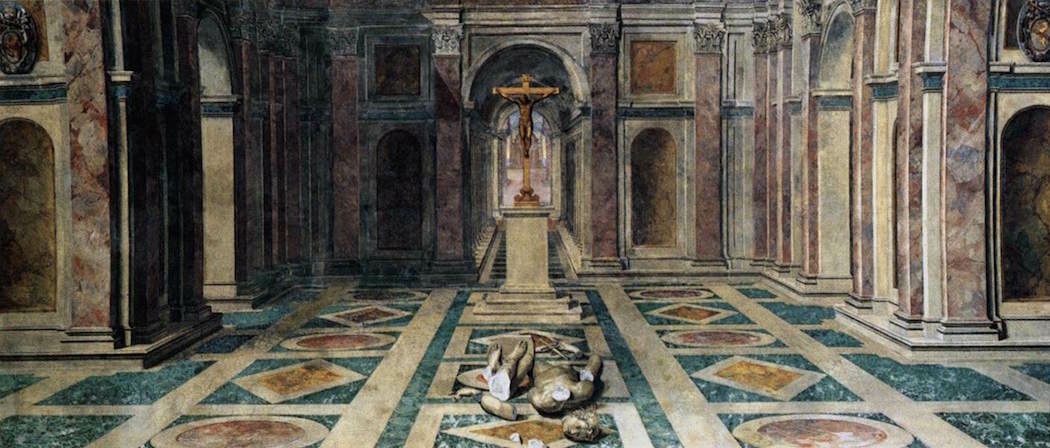
Although it was a bit cloudy it was a nice and the clouds made an excellent backdrop to the statues in St. Peter’s Square.
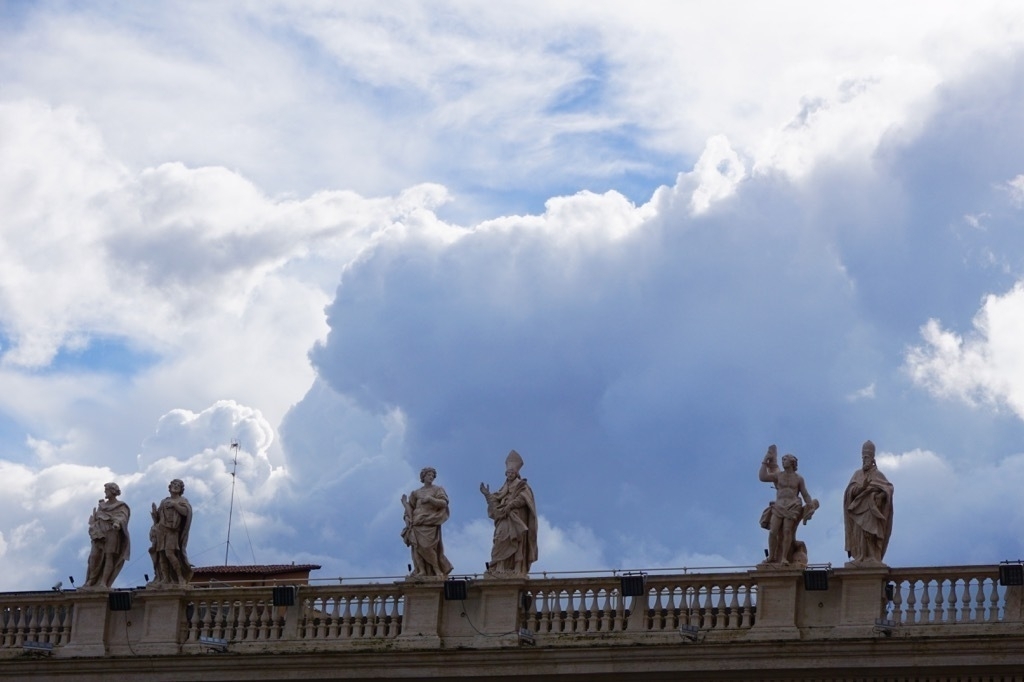
After the Vatican we turned the students loose for some time on their own. Jane and I went out in search of a restaurant. We, of course, had a couple in mind that Jane had researched prior to the trip. However that all went out the window when we were standing outside a pub only to see Ãzil score a goal for Arsenal against Tottenham. Now we were sucked in. Reviews aside, we were right across from the Vatican at what would surely be expensive, but there was football to watch. So into the Ris Cafe we went. Since many patrons were there getting lunch before the Italy Ireland Rugby match there were no tables available, so we agreed that as long as we could see the game sitting at the bar was fine. Soon a table opened up. But it had a horrible view of the game. So the manager asked the couple sitting at a different table to move to our table so we could have a better view. It was, but only marginally. We had just sat down and started to look at the menus when he came back and announced he had a better table for us in the other room. So we moved again. This time we had a great view of the game at a really nice table. Perfect. We were settled in and enjoying a pint of beer and the game. Ten minutes later the manager appeared again with a grin, and said “now you have to go back to the bar!” He started laughing, and we knew he was just having some fun with us. Sadly, the evil Tottenham Hotspurs outscored the Arsenal in the second half. Even more sadly, was that with four minutes left in the game, they changed the channel! The Ireland versus Italy rugby match was starting, and I believe we were the only people in the bar who cared one bit about Arsenal at that point!
Acclimating
Acclimating
A confession: I like my creature comforts. I like my nice modern home with in-floor heating and its “open concept” design. I like my big screen TV. I like my big kitchen with my fancy range, large refrigerator. I like things that are new and clean. I think that is part of what attracted to me to computer science.
When we were traveling in emerging economy countries like Vietnam or Cambodia we always knew that no matter what we saw during the day, we would return to our five star hotel in the evening and have all of the comforts of home. We saw some very poor living conditions in some of the places we visited, and I’m working on writing up a post about that, and what Jane and I took away from that experience.
But now we have moved into our flat in Malta, a developed country, with an advanced economy according the IMF. Yet, things feel very different and its going to take a while to acclimate. Moving in to a new country was always part of the excitement of taking on the directorship of the Malta program. The point was that we would get to settle in, and actually live in a place outside of the U.S. for an extended period of time. We are both excited about this opportunity.
With that in mind, I thought it would be interesting to note some of the things that stand out right now, in the first week or so, and then revisit this at the end of our time in Malta. I hope what I write in the coming paragraphs will not be construed as overly negative. I’m not judging, just trying to record my feelings and observations as we get used to a new place.
Living Arrangements
Yes, we are on a mediterranean island, but they have winter too. The highs have been in the mid fifties. We have had some rain each day, and a bit of wind. The winters are short, and we are told that the temperatures will begin to climb again at the end of February. Hurray! The views of the ocean are everywhere, and they are beautiful. I can’t wait for a bit warmer weather to take more pictures of the boats in all the little harbors.
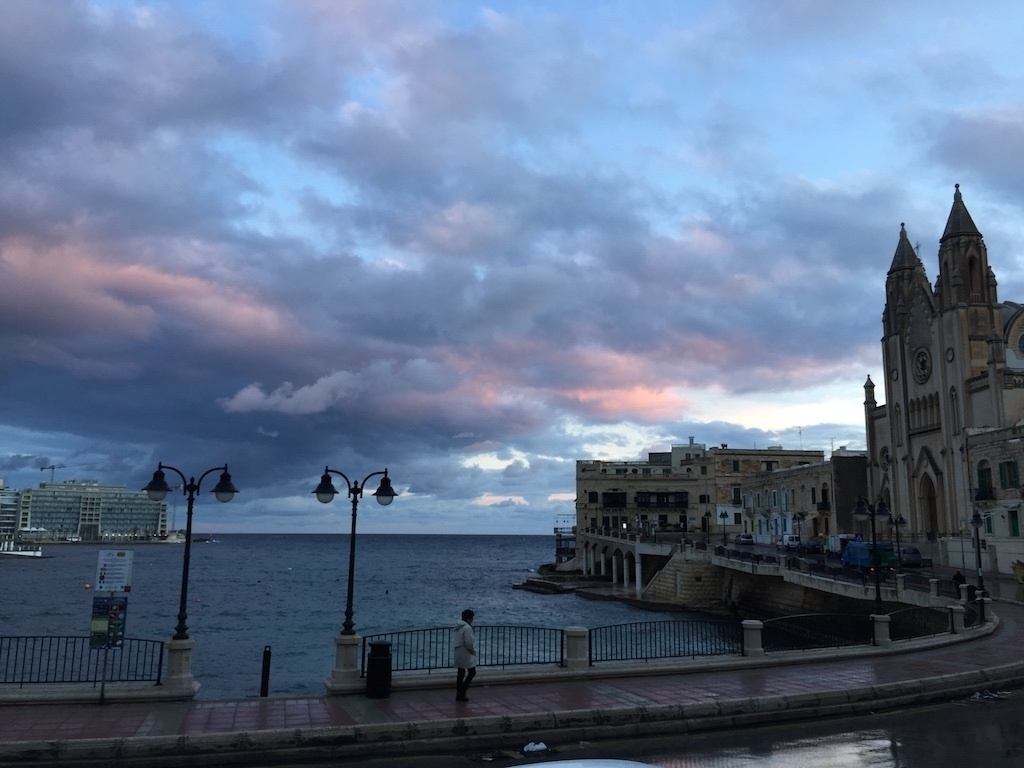
In the meantime, we are learning how to stay warm in a big stone building. We have no heating other than a little oil filled electric radiator, and an electric blanket on our bed at night. I SO want to go out and buy a big old 20,000 BTU gas powered heater and set it up in our hallway, but I think that will not happen. We are learning that running the dehumidifiers is important. Dryer air feels warmer. We dress in layers, and use blankets while relaxing in the evening. The chill has been the hardest thing to get used to in our first week. I hate being cold, and knowing that I’m here until June keeps me from finding a nice warm hotel room. We did join the health club at the Meridian Hotel, a few blocks away. The membership ensures us a nice place to work out, and a shower with LOTS of hot water. They also have a jacuzzi and a heated indoor pool that we can soak in to warm ourselves the evenings.
The odd thing is that in the daytime it is nicer outside than inside. So yesterday we had a nice lunch on the roof in the sunshine and it was very nice.
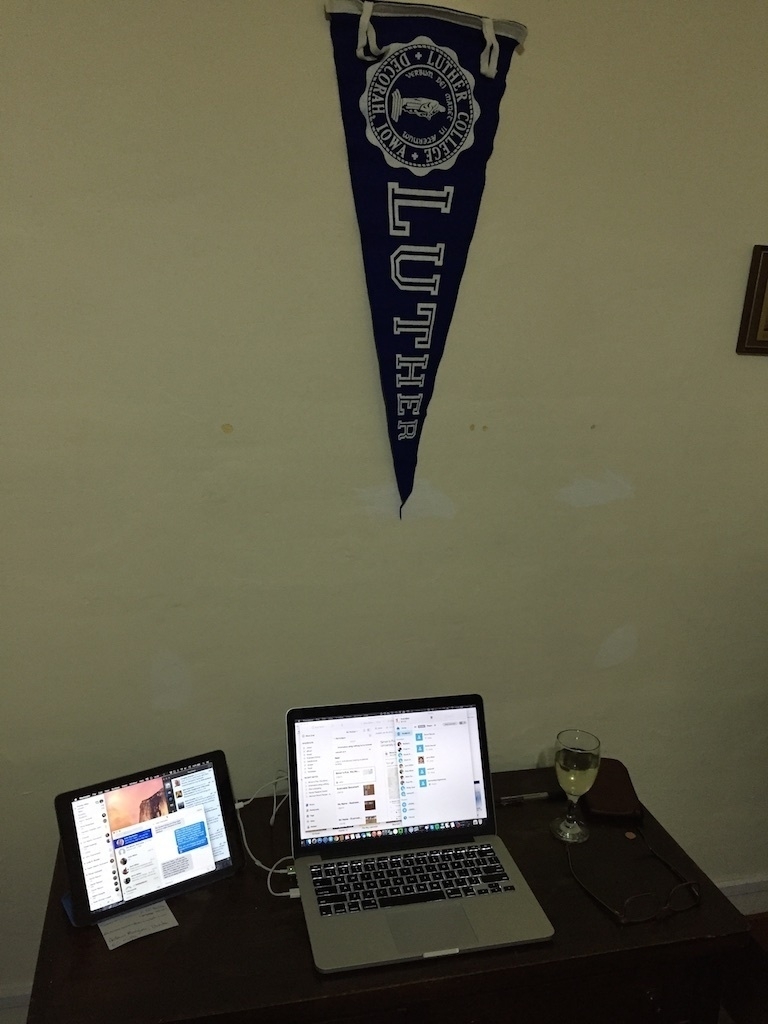
Getting around
We have no car. We have no bike. We have no scooter. So we walk, and walk, and walk. When we arrive at our building we climb 3 flights of stairs to get to our flat. Walking is good, but with all the hills my shins really suffered the first couple of days. They are getting better now. We are also learning the bus system for the longer trips. But really the island is not that big and we can walk almost anywhere to get what we need. We are told that the Maltese would be appalled, as they will drive their cars two blocks to the store rather than walk.
They have people to clean the streets and sidewalks regularly, but its amazing what litterbugs people are around here. And many people let their dogs poop on the sidewalk!! They just leave it there for the sidewalk cleaner to pick up later. Watch your step as you are walking. You have to be alert to many things while you are walking. First the sidewalks in most places are so narrow that you can’t really walk side by side. If you meet someone, chances are one of you is going to step out into the street. You just better hope one of the drivers doesn’t choose that moment to get the carbon out of their car and come roaring around a corner at you. Most of the streets are one way, and are only wide enough for one lane of traffic. I’ve talked to several people now about getting a bike and they have all strongly advised me against it!
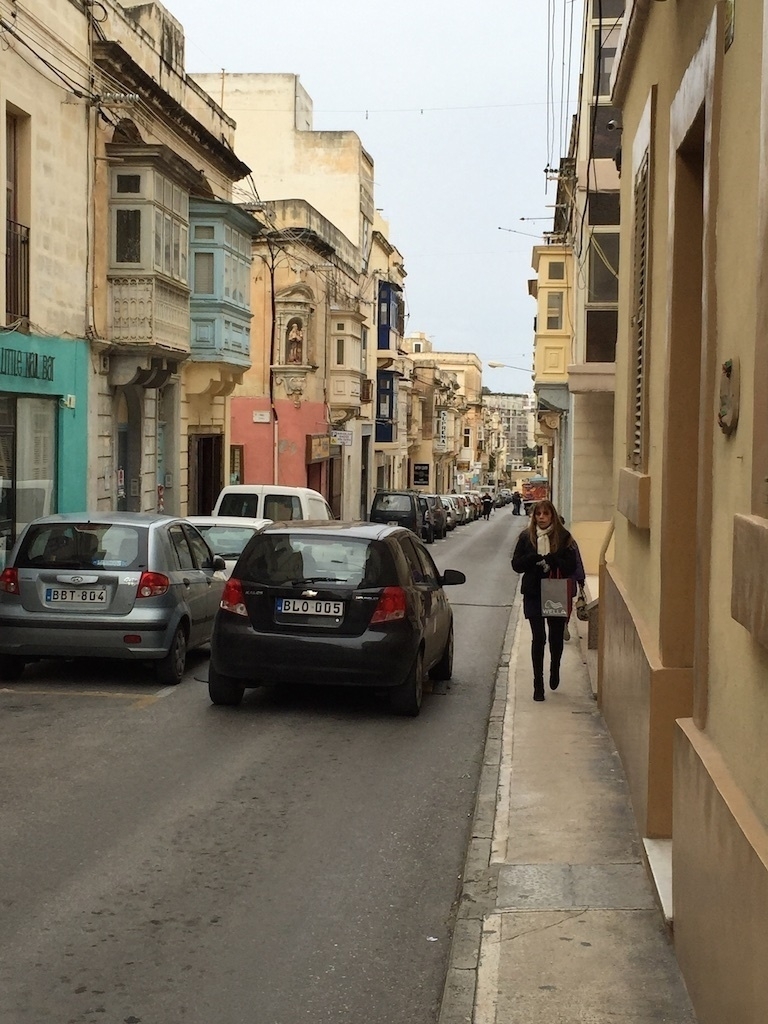
The People
We have been very fortunate to be welcomed to the island by some Luther alumni, both Maltese and American expats. This has been really nice. We haven’t really met many people in the neighborhood yet, but we have only been here a few days, so we surely look like we are just short term visitors to most people. The owner of the Ironmongery (a hardware store) was super nice to me today when I stopped by to purchase a gas grill for the roof. The people at the University have been very welcoming, and we have a long list of helpful advice and things to check out. We are looking forward to meeting more new people and reconnecting with Luther classmates who have come back to the island.
Everyone seems to speak english very well, and in fact english is the co-official language of Malta. However, most everyone we have run into seems to prefer to speak in Maltese. I assumed that it was probably a derivative of italian, since that is what it partially sounded like to my American ears, but in fact it is Siculo-Arabic. About half the vocabulary is standard italian, and 20% of the vocabulary is english, with the rest coming from this Sicilian Arabic dialect.
Shopping
There is nothing like a Target, or Walmart on the island. You do all your shopping at small neighborhood stores. If you need pharmaceuticals you go to the pharmacy on the corner. If you need a grill you go to the ironmongery on the other corner. If you need electronics you go to the electronics store. If you need wine, you can go, well, almost anywhere. Seriously, there are all kinds of little wine shops on every street. I honestly don’t know how they stay in business, from my own observations they don’t move a huge volume of wine in a day.
I kind of like this way of shopping. Its like we do back home for groceries, the coop for this, and Fareway for that, etc. However, back home I don’t hesitate to order from Amazon. Sadly, my Amazon Prime membership does not cover me here in Malta.
Another little thing to get used to is that most shops close up shortly after noon, and stay closed for an hour or two or three. Then they are open again until about 7 p.m.
Eating
Of course I saved my favorite topic until last. There is a wide variety of restaurants within walking distance of the flat. Great Pizza at Piccolo Padre is just a couple blocks away. Fish and Chips at the Scotsman Pub is a bit further, but appears to be a good place to watch EPL football, as does the Balluta bar just down the street, but we haven’t tried that place yet. Vecchia Napoli is another close by Italian place. We had lunch there the other day and found out that we had to sit outside under a heater since we had not reserved an indoor seat in advance! For lunch! We are trying to balance our eating habits so that we cook either lunch or dinner at home, and then try out a variety of eating places opposite. I’ll leave this post with my favorite discovery... I can buy an entire kilo of Parmigiano Reggiano for just 19 euros! I may need another suitcase to bring home my cheese!
We are generally late eaters back home. I don’t usually start cooking until around 6 p.m. But we are quickly learning that the dinner hour in Malta is very Mediterranean. Most places don’t even open for dinner until 7 or 7:30p.m. With the busy time coming around 9. Similarly, lunch time is also later with people eating at around 1 p.m.
One Night in Bangkok
One Night in Bangkok
After a short morning flight from Siem Reap, we arrived in Bangkok, for what seems a bit more like an extended layover than an actual stop on our trip. We leave for Malta in a few hours at 1:05 a.m. For our last night of our Asian adventure we are staying at the Oriental Residence in Bangkok. We are on the 19th floor, and this is our view of the city.
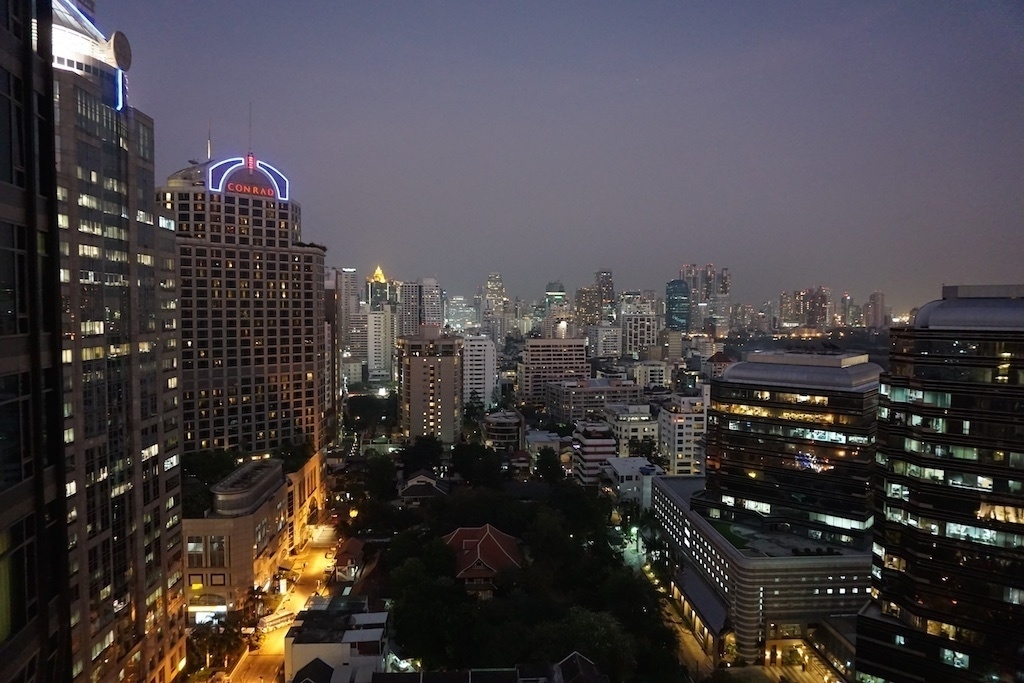
|
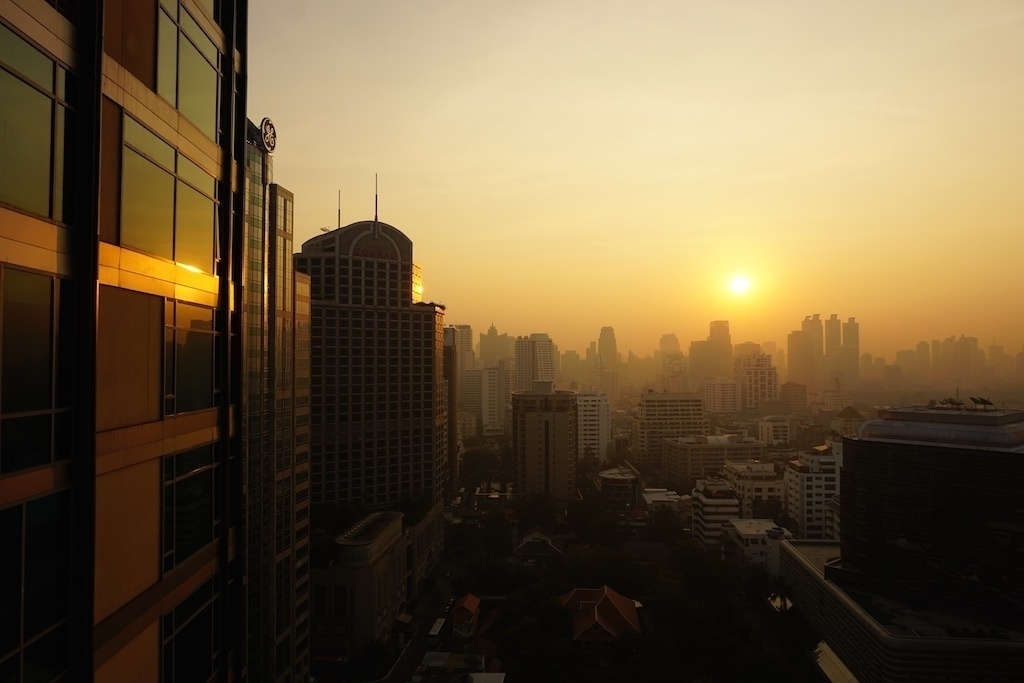
We had two very nice guides for yesterday afternoon and today. We visited the grand palace of the king, the summer palace, and a whole bunch of temples. The architecture of the Thai temples is different and interesting, and our guide yesterday filled in some gaps in our knowledge of Buddhism. In Bangkok, you can see temples built using a Thai architecture, Khmer architecture, and even a few Mosques. We saw temples within temples. We have lost count. I think it is safe to say that we are now “templed out.”
Bangkok itself is very different from anything we have seen in Vietnam and Cambodia. It is definitely a large modern city. Complete with massive traffic jams and loads of tourists. The food has been excellent. Green Curry, Massaman Curry, Tom Yum soup. Today out on the river we had the Tom Yum Goong (with prawns) and we told our guide to order it Thai style for us rather than “foreigner style.” Well, let me tell you, we like our food spicy but I lost my voice after a spoonful of this!! Oh My it was hot. We also had a chicken and basil stir fry that was absolutely delicious. How you can make something stir fried taste so spicy and like it just came off the grill, I don’t know. But I’m definitely going to be working on it. We have a few bags of spices in our luggage that I hope make it through immigration in Malta.
It is now time to start a new chapter of this journey and we are both looking forward to arriving in Malta in about 25 hours.
P.S. I hope the song gets stuck in your head for a day too. And just in case, you can’t remember, I’m not sure I ever really knew them all. But here are the lyrics:
Bangkok, Oriental setting And the city don’t know what the city is getting The creme de la creme of the chess world In a show with everything but Yul Brynner
Time flies, doesn’t seem a minute Since the Tirolean Spa had the chess boys in it All change, don’t you know that when you Play at this level, there’s no ordinary venue
It’s Iceland or the Philippines Or Hastings or, or this place
One night in Bangkok and the world’s your oyster The bars are temples but the pearls ain’t free You’ll find a God in every golden cloister And if you’re lucky then the God’s a she I can feel an angel sliding up to me
One town’s very like another When your head’s down over your pieces, Brother
It’s a drag, it’s a bore, it’s really such a pity To be looking at the board, not looking at the city
Whaddya mean? Ya seen one crowded, polluted, stinking town
Tea girls, warm and sweet, warm, sweet Some are set up in the Somerset Maugham Suite
“Get Thai’d”, you’re talking to a tourist Whose every move’s among the purest I get my kicks above the waistline, sunshine
One night in Bangkok makes a hard man humble Not much between despair and ecstasy One night in Bangkok and the tough guys tumble Can’t be too careful with your company I can feel the Devil walking next to me
Siam’s gonna be the witness To the ultimate test of cerebral fitness This grips me more than would A muddy old river or Reclining Buddha
But thank God, I’m only watching the game, controlling it
I don’t see you guys rating The kind of mate I’m contemplating I’d let you watch, I would invite you But the queens we use would not excite you
So you better go back to your bars, your temples Your massage parlors
One night in Bangkok and the world’s your oyster The bars are temples but the pearls ain’t free You’ll find a God in every golden cloister A little flesh, a little history I can feel an angel slidin' up to me
One night in Bangkok makes a hard man humble Not much between despair and ecstasy One night in Bangkok and the tough guys tumble Can’t be too careful with your company I can feel the Devil walking next to me
-- Murray Head
Ok fun fact about this song: Along with the rest of the songs from Chess, the music was written by Björn Ulvaeus and Benny Andersson of ABBA, and Tim Rice wrote the lyrics. Can you feel the love tonight?
Sixty Minutes of Inspiration
Sixty Minutes of Inspiration
Today was another one of those days that was thought-provoking, uplifting, and inspiring. This morning we had a new guide, who took us to his own village and showed us his own house. That experience will be a part of a post that has been brewing for a week or so. I’m going to do this one first as it is fresh in my mind.
We just got back from JWOC (yes, they pronounce it jay walk) which stands for Journeys Within Our Community. What a great experience! We didn’t really know a lot about what we were in for this afternoon, other than we were there to volunteer in a class, and it would involve speaking english. So far, so good.
Before I tell you about the class, and what we did, I want to give you a little background about JWOC and the educational system here in Cambodia. The latter is easy. Its pretty minimal. Students may go to school from ages six to fourteen. After that there is really not much for them. Students may go to a private school for further education, but they are pretty expensive for most people in Cambodia.
JWOC has programs in five key areas: Community Assistance, Clean Water, Microfinance, Free Classes, and Scholarships. The scholarship program is the heart of it all. Since 2005 JWOC has provided 120 scholarships for students to get a university education. However, these students must in turn give back by volunteering their time on another JWOC program. The instructor of the class we participated in this afternoon was one such student.
At the JWOC center in Siem Reap they have students from age 4 all the way to 60. The classes are open to anyone in the community and range from english, to sewing, to gardening, to computers. The class we worked with was a hospitality class. You can think of it as an enrichment course for students who are interested in improving their english so they can work in the hospitality industry. One student wanted to be a hotel receptionist, another told us he wanted to be guide.
We started out the class with everyone introducing themselves. There was much smiling and laughing and clapping as we went around the room. Their enthusiasm was infectious. After the intros we moved on to some role play1. The instructor paired us up, and I played the role of a tourist who wanted to book a room, while my student played the role of someone at the front desk of hotel. I had a list of features that I wanted in my room and he had information about what they had available and the associated prices. He was into it! First he had to clarify several points with the instructor, and then we started out. After working our way through a fairly lengthy conversation, he said. “We need to do this again. We need to be the best so that we can perform for the class.” So we did it again.
When the teacher asked for volunteers to do their role play for the class I think he might have been a little disappointed that there was no choice based on merit, but he was undaunted and quickly volunteered us for the job. Here we are in the front of the classroom playing our roles:
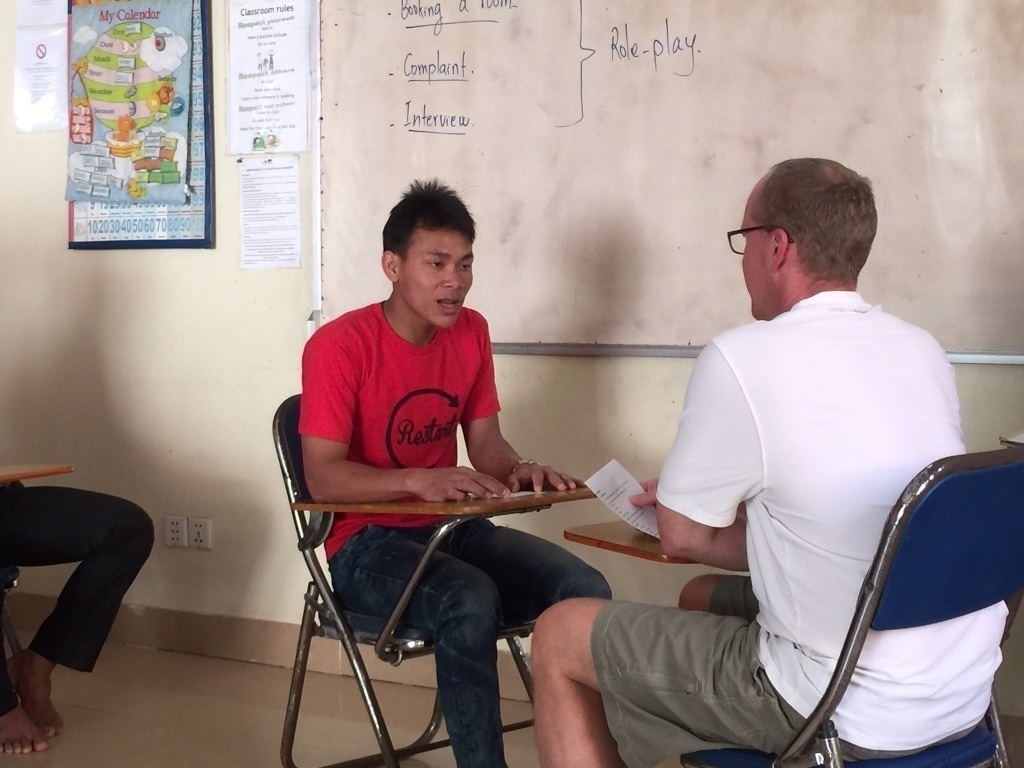
Jane also had an excellent student, that I wish I could have talked with some more. He wants to be an engineer, and is enthusiastically studying math and physics.
After the role playing was done we had about 20 minutes for free conversation. They divided the class in two, and put each of us with one group. The instructor said that since I was a professor they could ask me about anything. No pressure. We were all grinning from ear to ear even though they were a bit shy about asking questions. They wanted to know about where I was from, and what kind of crops we had, which led to a little discussion about how cold it is in Iowa. One of them was wearing a Chelsea shirt so that led to some quick conversation about football. Then I asked about what I should see or things I should eat. I think they were all impressed when I said we had already tried Amok and Lak Lok.
One student had been holding back and I could tell he wanted to ask me something, but he said he was to embarrassed. With a bit of coaxing he finally asked me: “what good are computers?” Well, now that is a question. Nobody laughed at him for asking it. What good is something that I take for granted and use all day everyday? So we talked about how you could use computers to learn things, anything you wanted to know you could find out. Only one of the students in my group had heard of Google! We talked a little about their markets and how they bought everything they wanted at the local market. I tried to describe how I used the computer to do my shopping. I can buy anything I want on the computer and a truck brings it to my house in two days. I may just as well have sprouted a second head.
Our hour was over in no time. But we left with such respect for these students. They were so enthusiastic and supportive of each other. It was a class like nothing I’ve experienced before.
Afterward we had a chance to talk with the education coordinator here in Siem Reap. She is an American from Connecticut who has been here about five months and had some nice insights to share with us. It is true that these students value education in a very different way because it is so special. She told us about the collaborative nature of the Cambodian culture and how important that is to their educational experience. Something that I never would have really understood before spending time here. But I’m glad that I did.
Here is the class with all of us all together.

-
Some great irony here as I’ve been known to skip out of faculty meetings where role playing is on the agenda. ↩︎
Siem Reap Cycling
Siem Reap Cycling
“Those stairs are too steep,” said our guid Sina. Those stairs must be climbed I said to myself. We were only about an hour into our afternoon of bike riding when we came across this out of the way temple. The staircases are at about a 60-70 degree angle to force people to focus on their climb to the top. We had been looking at these all day at various temples, but in each case the authorities had helpfully built a wooden staircase at a much more gentle angle. Out here away from the crowds was a chance to try the real thing. So, we rode around the back, there were identical stairs on all four sides, and I stopped my bike. “Just a few?” I asked? OK, So I quickly climbed up about 10 or 12 stairs. With a smile and a gesture Sina told me it was OK to continue as far as I wanted, which was all the way to the top.
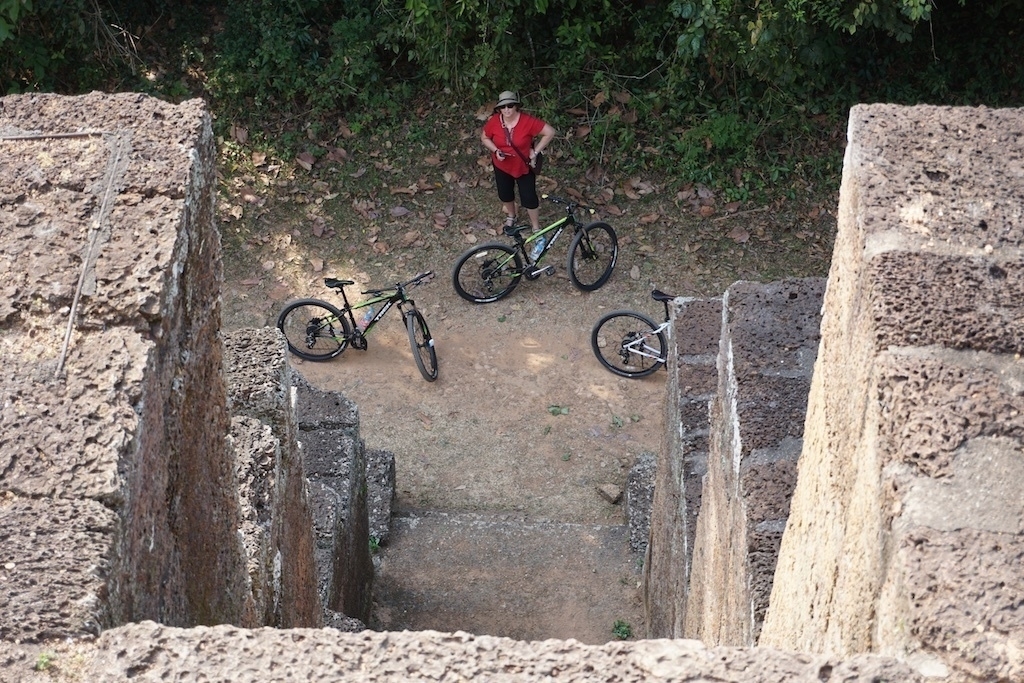
|

It turns out that this was just the beginning of a great afternoon of adventures on our rented mountain bikes. The bikes allowed us to get to places of the giant temple complex that most people don’t go to because its a long walk on paths that are not very well marked.
You carry your bike through a dry creek bed and an ancient door on the other side and you are treated to another amazing site. Way in the far back of the temple we did some serious mountain biking, and climbing. Even our guide asked us to take a picture of himself on his bike to show his friends. Actually I think he posted it on Facebook immediately. Look where I took the crazy Americans today! This was toward the end of our ride, so you can see some of the amazing golden colors of the late afternoon sun.
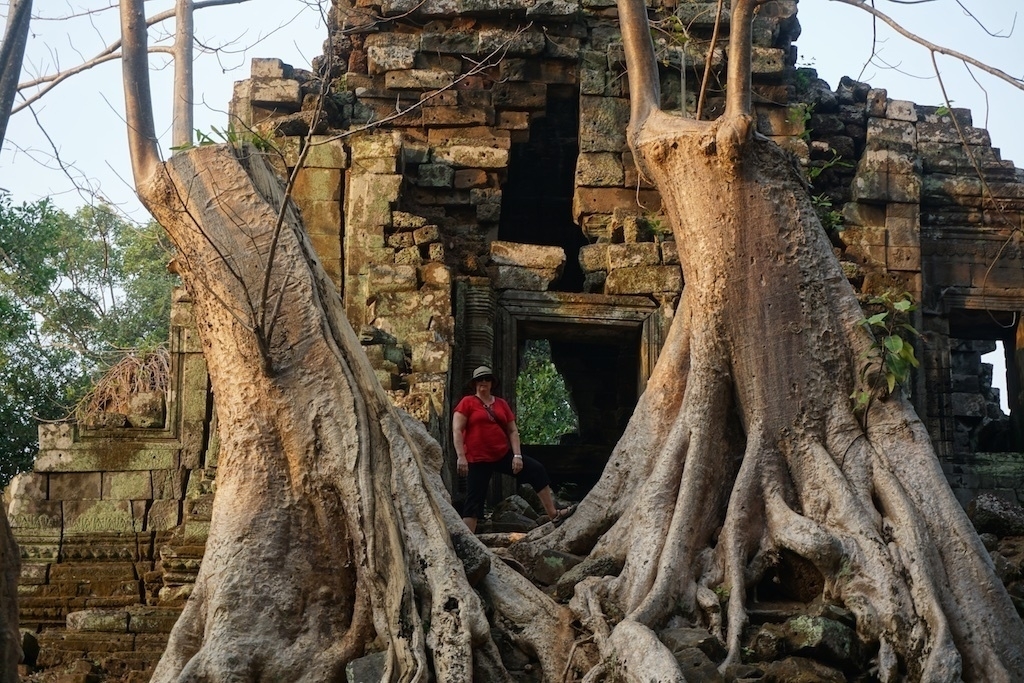
|
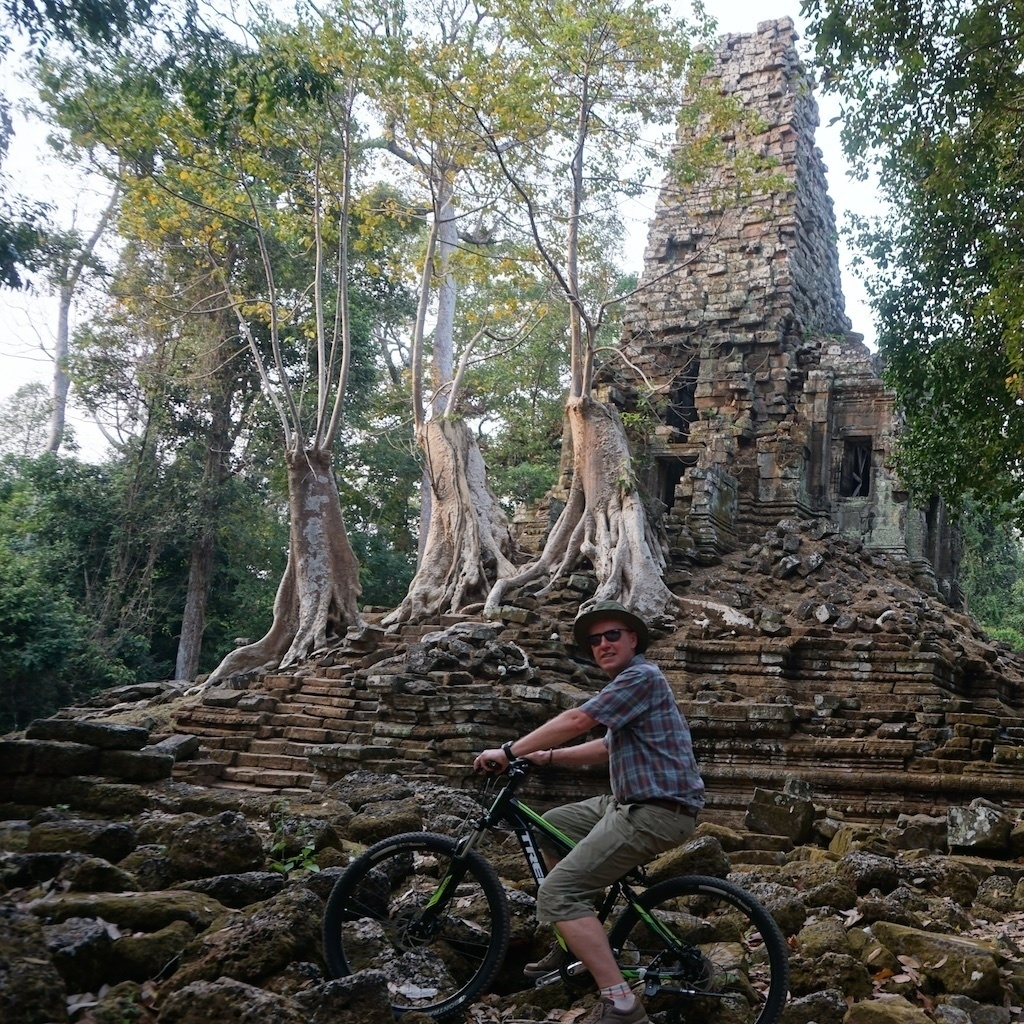
One place we did get off the bikes and walk around was at the Bayon temple. This was built by King Jayavarman VII. Yeah, I can’t say it either -- even after hearing our guide say it several times. We ended up just going by seven. My favorite was Udayadityavarman I who predated VII by about 80 years. Anyway, Jayavarman VII was a very long lived king, and a very good king. He built many temples, and took care of the people. They have a children’s hospital in Siem Reap named after him.

As you are walking through the temples with the guide it is really interesting to hear about the history. Many of the temples were originally built as Hindu temples and then later converted into Buddhist temples. Some are the other way around, it just depended on who was in charge at the time they were built.
Most of the temples we visited were built between 950 and 1180. At some point most of them were abandoned and fell into ruin until they were rediscovered largely by the French in the early 1900’s. Of course some of the discoverers were corrupt and tried to loot the temples and sell off the amazing bas relief stone carvings back home. But others financed the beginnings of the restoration of these places.
Every one of those towers in the Bayon temple has the face of Jayavarman VII on four sides. It is said that this symbolizes that the king was watching everything and everyone at all times.
Because the Cambodian government is quite corrupt, and it is quite a poor country, many of the restoration projects we saw over the last few days were financed by other countries. Some by Japan and Korea, to provide a great tourism experience for their people, others by India and other countries for maybe more altruistic reasons.
One other bit of excitement for the day happened when we made a comfort stop. It turned out the elephants were headed to the same place.
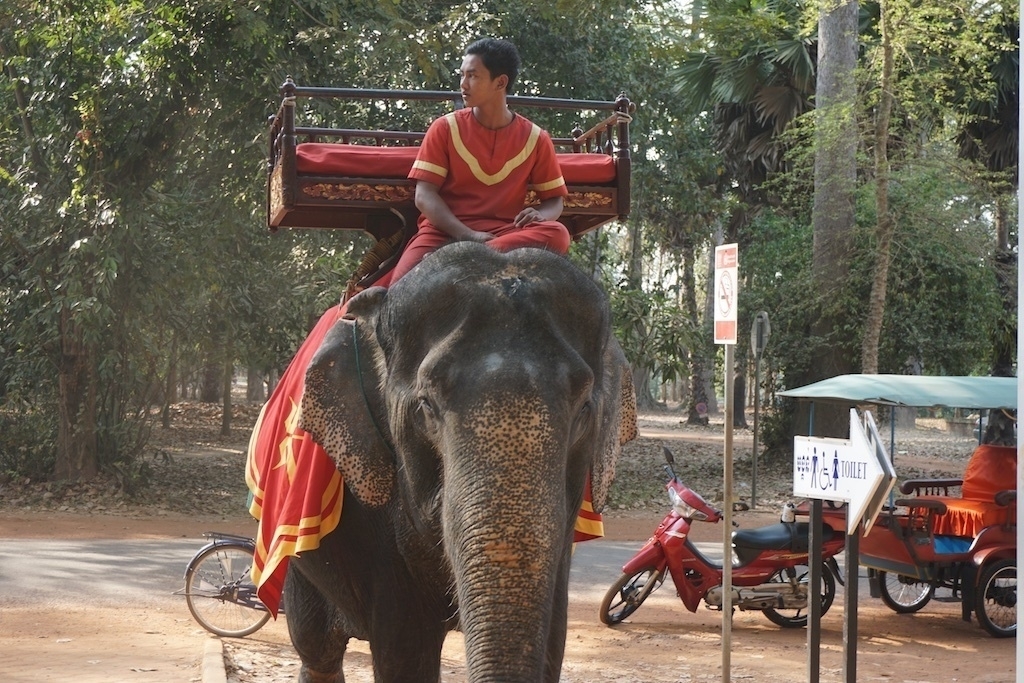
Early Morning Temple
Early Morning Temple
Wake up call, 4:30 a.m. Oh-dark-thirty as some would say. After a full day of travel yesterday, from Halong Bay, and a crazy arrival process in Siem Reap, we started our first full day in Cambodia plenty early. Our guide and driver met us at reception at 5 a.m and we headed for Angkor Wat in the darkness. We wanted to get a good spot to watch the sun rise behind the temple. When we got there the moon was still up and it was pitch dark. But as we sat and got to know our guide a bit, we began to see a shadow of the temple emerge from the dark sky. Gradually, the day dawned, and the clouds reddened and the temple became fully visible.
It was worth the short night to join the throngs of other people and see the sun come up. As we sat and began to wonder if we would see our friends Ann and Jerry among all of the other people there, Jane suddenly said “is that Jerry?” Then a moment later she spotted Ann and we started waving. So right there we had a little reunion with our friends and traveling companions. Since it was the right time, Jerry and I did an abbreviated workout in honor of our P90X buddies back home.
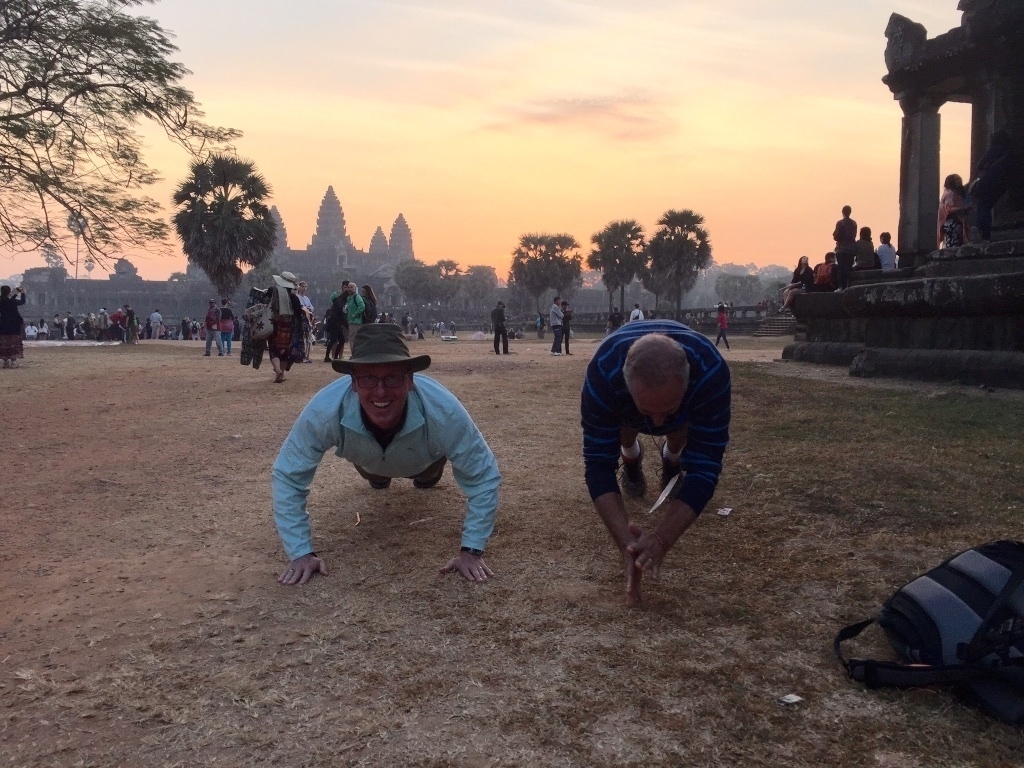
We each had to go on our way for the day, Jerry and Ann with their Luther Students in tow, and us with our Guide Sina to visit the temple. We will meet up with them for dinner in town tonight.
Right now we are resting after being at the temple for about 4 hours. We’ll meet our guide again at 1:00 for lunch and a bike ride to the Angkor Thom temple.
Lifestyle Reflections
Lifestyle Reflections
Note: I wrote the first part of this post as a draft, while in Cambodia, and then forgot to “un-draft” it. So I just realized four months later that it has not been finished or published. I will finish and publish it now.
Some of my earliest memories are of a small house in a small town in Southwestern Minnesota in the late 1960’s. My Grandma Sundahl lived in this house. As you came in the side door, you could turn left and go up a few stairs to the kitchen, or straight down the stairs to the basement. The basement had three rooms, a laundry room off to the left as you went down the stairs. I remember big crockery bowls on the counter in that room and a big black adding machine that we could play with endlessly. To the right was a cinder block room with a cement floor. Grandma had painted the walls and decorated them with big posters of the Campbell Soup kids. There was a ping pong table at one end. As far as I can remebmer the other end of that room was open for us to run around in. Straight ahead as you reached the bottom of the stairs was the big dark scary room. there was a shower in there, that I never really wanted to shower in. This was also the room where Grandpa Sundahl’s tools were.
In the kitchen the sink was straight ahead as you entered with a window to the back yard yard. I remember using the hand mixer in that sink hundreds of times to make more bubbles out of the dish soap. To the right of the sink was a stack of shelves. The third door down was the magic drawer. There was always a package of M&M’s for each of us, and this was where Grandma kept the matches for her cigarettes, which we hid endlessly. Behind the sink was the gas stove and refrigerator. A felix the cat clock was on the wall over the small kitchen table.
In the living room was a black and white television. If we wanted to watch Rocky and Bullwinkle we would have to turn the rotor to point the antenna towards Sioux Falls in the west. Sadly, Lawrence Welk was non-negotiable and required the rotor to point the antenna towards Mankato in the Northwest.
The upstairs was my personal kingdom. The stairway divided the small dormer style upstairs room into two halves. There was a half-wall around the stair to keep you from falling, and we would endlessly pile up grandma’s pillows on a blanket that we stretched across and over the stair. We would call grandma to come upstairs and then drop the pillows on her. Amazingly she never caught on.
In Storden we were allowed to walk anywhere on our own. We could go to Witt’s grocery store and get groceries for grandma, and of course a pushup, or some other ice cream treat for our efforts. As far as I remember no money was exchanged everything was done on account. Down the road from the grocery store was the elementary school with swings, teeter totters, and of course the tall metal slippery slide with a big hump in the middle. Nothing was made of plastic in those days, there were no soft recycled bits of anything to land in at the bottom of the slide.
You may be wondering why I’ve just written four paragraphs of memories about small town Minnesota life in the late 60’s when I’m in the middle of Cambodia. Actually I’m a bit surprised myself, but once I started, the memories kept following one after the other, and it seemed right to get them down. Maybe this blog needs a good editor! Still, its a valid question.
I’ve been thinking a lot about those early days as I’ve been traveling through Vietnam and now Cambodia these last few weeks. Its not a conscious effort on my part, the memories just keep arising as we drive around.
My learning style is to make connections between things I know and the things I’m learning. I find patterns, and make associations. You may be wondering what connections and parallels I see between Southwest Minnesota and the Southeast Asian countries of Vietnam and Cambodia. To me the parallels are obvious.
For me, these memories of my childhood represent a simple “make do” style of living. We had fun, but it wasn’t expensive and it wasn’t complicated. Later in life I learned that my Mom, the oldest child, and grandma and grandpa had lived in the basement for a period in order to save the money to build the rest of the house.
### Here we pick up the thread several months later
After four months in Malta and around the Mediterranean, I think I understand why I was writing a lot of what I wrote. I comes down to thinking about your own lifestyle. The stark contrast in January between my own lavish lifetyle and the lifestyle I’ve lived in Malta these last four months is pretty amazing. I have learned to live with a lot less than I do at home, I have learned to enjoy cooking and eating even without my gourmet kitchen, I have accomplished a lot of development work on projects that I am truly passionate about with nothing but a laptop and an internet connection.
The flat we live in was built in the 1950’s probably a decade after the house in Storden was built. There is almost nothing in common between this long narrow limestone flat, and the house in Storden other than the shared experiences of the members of the generation that built each structure.
One of the interesting things about Malta is that the tension between the generations is more evident to me on Malta than it is in my own country. There is a real sadness among the older generation about how the island has changed in the last 30 years, and i guess I honestly can’t say how the younger generation feels, but I can observe their actions as they overbuild, and overuse the limited resources available to them on the island.